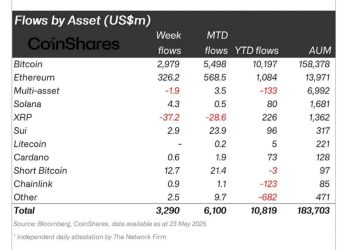The Circle Payments Network will make international payments faster, cheaper and more transparent using the USDC stablecoin for settlement.
The Circle Payments Network’s mainnet has gone live, bringing a USDC stablecoin-powered solution to cross-border payments.
USDC-issuer Circle said the first transactions are already happening in an X post announcing the news.
“Cross border payments represent a $190 trillion market that is fragmented, opaque, slow, and manual,” the company said. “Settlement takes days. Capital sits idle. Visibility is limited.”
It is also expensive, Circle said, pointing to a World Bank report that said cross-border transactions can cost as much as 6%.
The Circle Payment Network (CPN) brings blockchain speed and security to cross-border transfers, Circle said, adding, “It is not just faster. It is programmable, transparent, and always-on.” And a whole lot cheaper.
Circle is working with Banco Santander, Deutsche Bank, Société Générale, and Standard Chartered Bank to ensure that CPN is “built with high standards of trust and operational integrity,” the company said in a statement.
Real-time Global Settlement
“The launch of the Circle Payments Network is a major step forward for real-time, global finance,” said Joe Sticco, co-founder of Cryptex Finance, in an email to The Defiant. “While stablecoins like USDC may not immediately replace Venmo or Zelle for everyday U.S. consumers, their impact will be profound in cross-border and institutional payments.”
Noting that the network strips out the traditional banking system’s inefficiencies while working every day around the clock — something the current SWIFT system does not — Sticco said CPN is “a meaningful milestone on the path to making blockchain-based finance infrastructure truly interoperable with the global financial system.”
The importance is simple, added Patrick Gerhart, president of Banking Operations at Telcoin, a DeFi platform focused on mobile phone users. “This network will help regulated businesses and financial entities to more efficiently pay each other using stablecoins and aspects of public blockchains, but in a compliant manner that satisfies necessary rules and regulations,” he said.
What it doesn’t do is help consumers buy a cup of coffee, Gerhart noted. “Domestically in the United States, payments for coffee and goods will happen using stablecoins, but it will likely take longer to gain mass adoption, given that the existing payment infrastructure is relatively good and already natively uses dollars. Stablecoins are especially helpful for those in countries who lack access to dollars.”
Workers sending remittances home will be the first U.S. residents to use the system directly.
Yield-bearing Stablecoins Grow Despite Regulatory Limbo
USDC, with a market capitalization of $60.5 billion, doesn’t offer holders yield on its stablecoins. Nor does market leader Tether’s USDT, with a market cap of $152 billion.
However, the market for stablecoins offering yield is growing rapidly, according to a new report from blockchain investment firm Spartan Group.
Yield-bearing stablecoins have grown from a market cap of less than $1.5 billion at the start of 2024 to $11 billion today.
“Yield-bearing stablecoins could be especially beneficial for anyone, but there are disagreements over enabling such yield-bearing stablecoins that could restrict their availability in the United States,” Gerhart said.
In the U.S., yield-bearing stablecoins are in a precarious position as banks are fighting tooth and nail to have them banned under the stablecoin regulatory legislation expected to come out of Congress in the coming weeks. Banks fear that yield-bearing stablecoins could tempt people away from using bank accounts, which offer almost no interest.
#Circle #Takes #Aim #SWIFT #CrossBorder #Payments #Network





















